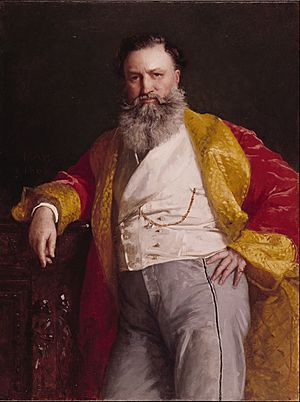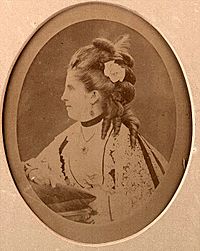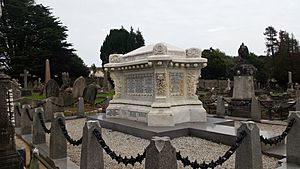Isaac Singer facts for kids
Quick facts for kids
Isaac Singer
|
|
|---|---|

Singer in 1869
|
|
| Born | October 27, 1811 Pittstown, New York, U.S.
|
| Died | July 23, 1875 (aged 63) Paignton, Devon, U.K.
|
| Known for | Founder of the Singer Sewing Machine Company |
| Spouse(s) |
Catherine Maria Haley
(m. 1830; div. 1860)Isabella Eugenie Boyer
(m. 1863) |
| Partner(s) | Mary Ann Sponsler (1836–1861) |
| Children | 26 |
Isaac Merritt Singer (October 27, 1811 – July 23, 1875) was an American inventor, actor, and businessman. He made important improvements in the design of the sewing machine and was the founder of what became one of the first American multi-national businesses, the Singer Sewing Machine Company.
Many others, including Walter Hunt and Elias Howe, had patented sewing machines before Singer, but his success was based on the practicality of his machine, the ease with which it could be adapted to home use and its availability on an installments payment basis.
Contents
Early life
Isaac Merritt Singer was born on October 27, 1811, in Pittstown, Schaghticoke, New York. He was the youngest of eight children born to a German father, Adam Singer (né Reisinger) (1772–1855), and his American wife, Ruth (née Benson) Singer. His siblings were John Valentine Singer, Alexander Singer, Elizabeth (née Singer) Colby, Christiana (née Singer) Cleveland, and Elijah Singer. In 1821, his parents divorced and his mother abandoned Isaac. At twelve, he ran away from home to join a traveling stage act, called the Rochester Players, after finding bits of work as a joiner and lathe operator.
Career
In 1839, Singer obtained his first patent, for a machine to drill rock, selling it for $2,000 (or over $50,000 in 2018 dollars) to the I & M Canal Building Company. With this financial success, he opted to return to his career as an actor. He went on tour, forming a troupe known as the "Merritt Players", appearing onstage under the name "Isaac Merritt", with Mary Ann Sponsler (one of his mistresses) also appearing onstage, calling herself "Mrs. Merritt". The tour lasted about five years.
He developed and patented a "machine for carving wood and metal" on April 10, 1849.
At 38, with Mary Ann and eight children, he packed up his family and moved back to New York City, hoping to market his wood-block cutting machine. He obtained an advance to build a working prototype, and constructed one in A. B. Taylor & Co shop, where he met G. B. Zieber, who became Singer's financier and partner. However, not long after the machine was built, the steam boiler blew up at the shop, destroying the prototype. Zieber persuaded Singer to make a new start in Boston, a center of the printing trade. The singer went to Boston in 1850 to display his invention at the machine shop of Orson C. Phelps. Orders for Singer's wood cutting machine were not, however, forthcoming.
Lerow & Blodgett sewing machines were being constructed and repaired in Phelps' shop. Phelps asked Singer to look at the sewing machines, which were difficult to use and produce. Singer concluded that the sewing machine would be more reliable if the shuttle moved in a straight line rather than a circle, with a straight rather than a curved needle. Singer was able to obtain US Patent number 8294 for his improvements on August 12, 1851.
I. M. Singer & Co
In 1856, manufacturers Grover & Baker, Singer, Wheeler & Wilson, all accusing each other of patent infringement, met in Albany, New York to pursue their suits. Orlando B. Potter, a lawyer and president of the Grover and Baker Company, proposed that, rather than squander their profits on litigation, they pool their patents. This was the first patent pool, a process which enables the production of complicated machines without legal battles over patent rights. They agreed to form the Sewing Machine Combination, but for this to be of any use, they had to secure the cooperation of Elias Howe, who still held certain vital uncontested patents. Terms were arranged; Howe received a royalty on every sewing machine manufactured.
Sewing machines began to be mass-produced. I. M. Singer & Co manufactured 2,564 machines in 1856, and 13,000 in 1860 at a new plant on Mott Street in New York. Later, a massive plant was built near Elizabeth, New Jersey.
Up to then, sewing machines had been industrial machines, made for garments, shoes, bridles and for tailors, but in 1856, smaller machines began to be marketed for home use. However, at the then enormous price of over $100 ($3,257 in 2022 dollars), few sold. Singer invested heavily in mass production utilizing the concept of interchangeable parts developed by Samuel Colt and Eli Whitney for their firearms. He was able to cut the price in half, while at the same time increasing his profit margin by 530%. Singer was the first who put a family machine, "the turtle back", on the market. Eventually, the price came down to $10 ($326 in 2022 dollars). According to PBS, "His partner, Edward Cabot Clark, pioneered installment purchasing plans and accepted trade-ins, causing sales to soar."
Women were able to make items at home for their families or for sale and charitable groups began to support poorer women to find useful skills and respectable employment in sewing, such as The Ladies Work Society (1875), The Association for the Sale of Works of Ladies of Limited Means, The Co-operative Needlewoman's Society and associated magazines, pattern books and group classes began for the better off women who also wanted to have some form of useful, economic activity, which a sewing machine at home now offered.
I. M. Singer expanded into the European market, first starting in Bonnybridge, Stirlingshire, next to the iron foundries that supplied the castings for the chassis until expansion was hindered by the expansion of the foundries around them and they then moved to Clydebank, establishing the world's largest sewing machine factory, built between 1882 and 1885, by George McKenzie in Kilbowie, Clydebank, near Glasgow, consisting of two main manufacturing buildings on three levels (one building for making the domestic machines, the other for industrial model production), with a 200 ft (over 60meters) high tower with the 'Singer' name logo and four clock faces which was the largest four-sided clock tower at the time. Singer opened the factory at Clydebank with 3,500 people making 8,000 sewing machines a week on average. The factory was linked directly to railway lines, and via stations in Dumbarton and Helensburgh to assist in distribution. Later improvements included a further two levels for the production blocks and a power station and sawmills. (Note: images of the tower and the factory's transport connections are available on the Scottish National Buildings Record) The factory later supplied military and home sewers, and made munitions during World War II. In 1941, the factory and area was severely damaged (losing 390,000 sq ft 36,000 sq m) in the 'Clydebank Blitz' when at least 35,000 homes were damaged and 500 people, including 39 Singer workers were killed.
Even as early as 1880, Singer machines compared favorably with their nearest competitors: information articles becoming marketing tool. By the 1900s, this factory, controlled by the parent company, made 1.5million machines sold around the world, helping the Singer company in becoming one of the first American-based multinational corporations, with agencies in Paris and Rio de Janeiro.
Later as The Singer Manufacturing Company and its competitors expanded, due to its affordability (or purchase plan terms) by the 1940s there were 24,000 sewing classes a year running in the UK alone, and the 1944 Education Act made practical dressmaking a compulsory subject for girls in all state schools. By the 1950s, there were Singer Teen-Age Sewing Classes and advertising campaigns to encourage girls to make their own fashions to attract boys' interest.
Changes to company in Europe
In 1863, I. M. Singer & Co. was dissolved by mutual consent with Edward Cabot Clark seeing Singer's reputation as a risk to growth; but the business continued with Singer owning 40% of shares and still on the Board, as "The Singer Manufacturing Company," in 1887.
In 1871, Singer purchased an estate and settled with Isabella in Paignton, Devon, England. He commissioned the 110-roomed Oldway Mansion as his private residence, with a hall of mirrors, maze and grotto garden; it was rebuilt by Paris Singer, his third son from Isabella, in the style of the Palace of Versailles. And the area became known locally as 'Singerton'. It has been named by the Victorian Society as a heritage building at risk of disrepair.
Consequence on global garment industry
Singer's prototype sewing machine became the first to work in a practical way. It could sew 900 stitches per minute, far better than the 40 of an accomplished seamstress on simple work. This started the industrialisation of garment and textile manufacturing, as a shirt took an hour to make compared to fifteen hours previously, but these still needed finishing by hand, and the finishers worked alone on piecework terms at home, but mass over-production by factories' machines, led to pressure on wages and to unemployment.
In 1911, most of the mainly female workforce at the Clydebank Singer factory went on strike in support of 12 workers who had objected to increased workload and lower pay conditions imposed (by this time there were 11,500 employees). Although the strike did not succeed, Singer fired 400 workers including the union leaders. The Singer Strike was one of the key actions leading to protests known as Red Clydeside.
In the 1960s, Japanese production efficiency brought aluminium body machines and products at lower pricing which outsold the cast iron Singer machines. The symbolic tower was knocked down as the Singer Clydebank factory was modernised, but it closed in 1980 and was demolished in the late 1990s.
Personal life
Singer died in 1875, dividing his $13 million fortune unequally among 20 of his living children by his wives and various mistresses, although one son, who had supported his mother in her divorce case against Singer, received only $500. Altogether he fathered 26 children.
His funeral was an elaborate affair with eighty horse-drawn carriages, and around 2,000 mourners, to see him buried locally in Torquay Cemetery, at his request in three layers of coffin (cedar lined with satin, lead, English oak with silver decoration) and a marble tomb. He decided not to have a will.
Legacy and honors
- The World War II Liberty Ship SS Isaac M. Singer was named in his honor.
- Singer Island, Florida was named for his son Paris Singer
See also
 In Spanish: Isaac Merritt Singer para niños
In Spanish: Isaac Merritt Singer para niños




